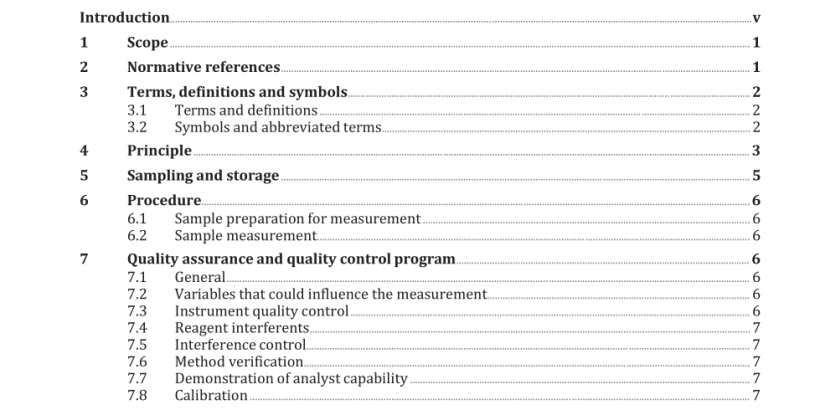ISO 13163:2021 pdf download – Water quality — Lead-210 — Test method using liquid scintillation counting.
1 Scope This document specifies a method for the measurement of scintillation counting (LSC). 210 in all types of waters by liquid The method is applicable to test samples of supply/drinking water, rainwater, surface and ground water, as well as cooling water, industrial water, domestic, and industrial wastewater after proper sampling and handling, and test sample preparation. Filtration of the test sample is necessary. Lead-210 activity concentration in the environment can vary and usually ranges from 2 mBq l to 300 mBq l . Using currently available liquid scintillation counters, the limit of detection of this method for Pb is generally of the order of 20 mBq l to 50 mBq l , which is lower than the WHO criteria for safe consumption of drinking water (100 mBq l ). These values can be achieved with a counting time between 180 min and 720 min for a sample volume from 0,5 l to 1,5 l. Higher activity concentrations can be measured by either diluting the sample or using smaller sample aliquots or both. The method presented in this document is not intended for the determination of an ultra-trace amount of Pb. The range of application depends on the amount of dissolved material in the water and on the performance characteristics of the measurement equipment (background count rate and counting efficiency). The method described in this document is applicable to an emergency situation. The analysis of Pb adsorbed to suspended matter is not covered by this method. It is the user ’s responsibility to ensure the validity of this test method for the water samples tested.
2 Normative references The following documents are referred to in the text in such a way that some or all of their content constitutes requirements of this document. For dated references, only the edition cited applies. For undated references, the latest edition of the referenced document (including any amendments) applies. ISO/IEC Guide 98-3, Uncertainty of measurement — Part 3: Guide to the expression of uncertainty in measurement (GUM:1995) ISO/IEC Guide 99, International vocabulary of metrology — Basic and general concepts and associated terms (VIM) ISO 3696, Water for analytical laboratory use — Specification and test methods ISO 5667-1, Water quality — Sampling — Part 1: Guidance on the design of sampling programmes and sampling techniques ISO 5667-3, Water quality — Sampling — Part 3: Preservation and handling of water samples ISO 5667-10, Water quality — Sampling — Part 10: Guidance on sampling of waste water ISO 11929 (all parts), Determination of the characteristic limits (decision threshold, detection limit and limits of the coverage interval) for measurements of ionizing radiation — Fundamentals and application ISO/IEC 17025, General requirements for the competence of testing and calibration laboratories ISO 19361, Measurement of radioactivity — Determination of beta emitters activities — Test method using liquid scintillation counting ISO 80000-10, Quantities and units — Part 10: Atomic and nuclear physics
3 Terms, definitions and symbols 3.1 Terms and definitions For the purposes of this document, the terms and definitions given in ISO 80000-10, the ISO 11929 series, ISO/IEC Guide 98-3 and ISO/IEC Guide 99 apply ISO and IEC maintain terminological databases for use in standardization at the following addresses: — ISO Online browsing platform: available at https://www.iso .org/obp — IEC Electropedia: available at http://www.electropedia .org/
4 Principle Lead-210 is a naturally occurring beta-emitting radionuclide with a maximum beta-energy of 63,5(5) keV and a half-life of 22,23(12) years . It appears in the U decay series (4n+2) as a long- lived decay product of Rn (see Figure 1). This document describes the measurement of Pb after separation from its progeny, Bi and Po and its activity is measured by liquid scintillation counting, either immediately after its separation or indirectly after ingrowth of its progeny Bi . Lead-210 is chemically purified from potential interferents, which consist of any isotope that can make the liquid scintillator emits light in the region of interest (ROI) of Pb. Different methods for the purification of Pb are presented in Annex A . After removal of the potential interferents, the chemical recovery of lead (R c ) is determined. The purified sample is mixed with the scintillation cocktail in a counting vial to obtain a homogenous medium. The vial is counted by LSC. Because of their identical separation behaviour in the extraction chromatographic procedure and their half-lives, Pb, Pb, and Pb are potential interferences ( Table 1). To avoid the possible interferences of the isotopes with short half-lives such as Pb and Pb and their progeny during the liquid scintillation counting, it is recommended to wait at least 3 h between elution of lead and sample counting to allow these radionuclides to substantially decay.
